Input interpretation

methyl iodide
Chemical names and formulas
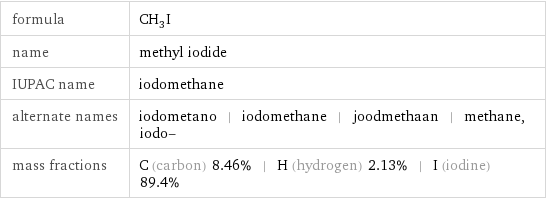
formula | CH_3I name | methyl iodide IUPAC name | iodomethane alternate names | iodometano | iodomethane | joodmethaan | methane, iodo- mass fractions | C (carbon) 8.46% | H (hydrogen) 2.13% | I (iodine) 89.4%
Lewis structure
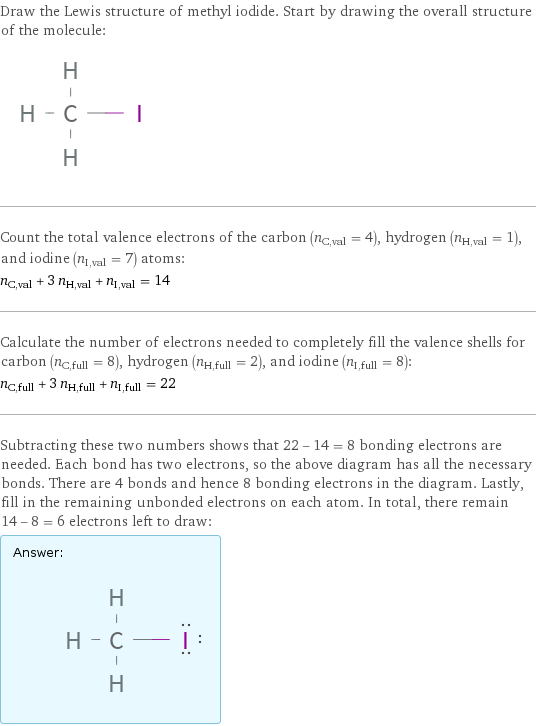
Draw the Lewis structure of methyl iodide. Start by drawing the overall structure of the molecule: Count the total valence electrons of the carbon (n_C, val = 4), hydrogen (n_H, val = 1), and iodine (n_I, val = 7) atoms: n_C, val + 3 n_H, val + n_I, val = 14 Calculate the number of electrons needed to completely fill the valence shells for carbon (n_C, full = 8), hydrogen (n_H, full = 2), and iodine (n_I, full = 8): n_C, full + 3 n_H, full + n_I, full = 22 Subtracting these two numbers shows that 22 - 14 = 8 bonding electrons are needed. Each bond has two electrons, so the above diagram has all the necessary bonds. There are 4 bonds and hence 8 bonding electrons in the diagram. Lastly, fill in the remaining unbonded electrons on each atom. In total, there remain 14 - 8 = 6 electrons left to draw: Answer: | |
3D structure

3D structure
Basic properties
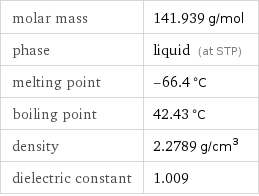
molar mass | 141.939 g/mol phase | liquid (at STP) melting point | -66.4 °C boiling point | 42.43 °C density | 2.2789 g/cm^3 dielectric constant | 1.009
Liquid properties (at STP)
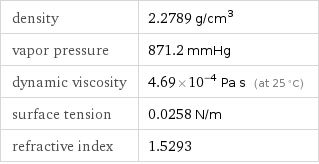
density | 2.2789 g/cm^3 vapor pressure | 871.2 mmHg dynamic viscosity | 4.69×10^-4 Pa s (at 25 °C) surface tension | 0.0258 N/m refractive index | 1.5293
Units

Thermodynamic properties
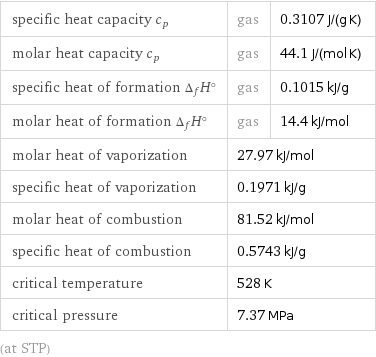
specific heat capacity c_p | gas | 0.3107 J/(g K) molar heat capacity c_p | gas | 44.1 J/(mol K) specific heat of formation Δ_fH° | gas | 0.1015 kJ/g molar heat of formation Δ_fH° | gas | 14.4 kJ/mol molar heat of vaporization | 27.97 kJ/mol | specific heat of vaporization | 0.1971 kJ/g | molar heat of combustion | 81.52 kJ/mol | specific heat of combustion | 0.5743 kJ/g | critical temperature | 528 K | critical pressure | 7.37 MPa | (at STP)
Chemical identifiers

CAS number | 74-88-4 Beilstein number | 969135 PubChem CID number | 6328 PubChem SID number | 24869230 SMILES identifier | CI InChI identifier | InChI=1/CH3I/c1-2/h1H3 MDL number | MFCD00001073
NFPA label

NFPA label

NFPA health rating | 3 NFPA fire rating | 1 NFPA reactivity rating | 0
Safety properties
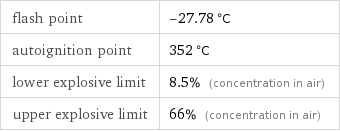
flash point | -27.78 °C autoignition point | 352 °C lower explosive limit | 8.5% (concentration in air) upper explosive limit | 66% (concentration in air)

DOT hazard class | 6.1 DOT numbers | 2644
Toxicity properties

short-term exposure limit | 56 mg/m^3 threshold limit value | 2 ppmv

long-term exposure limit | 28 mg/m^3 (over 8 hours) RTECS classes | tumorigen | mutagen | primary irritant